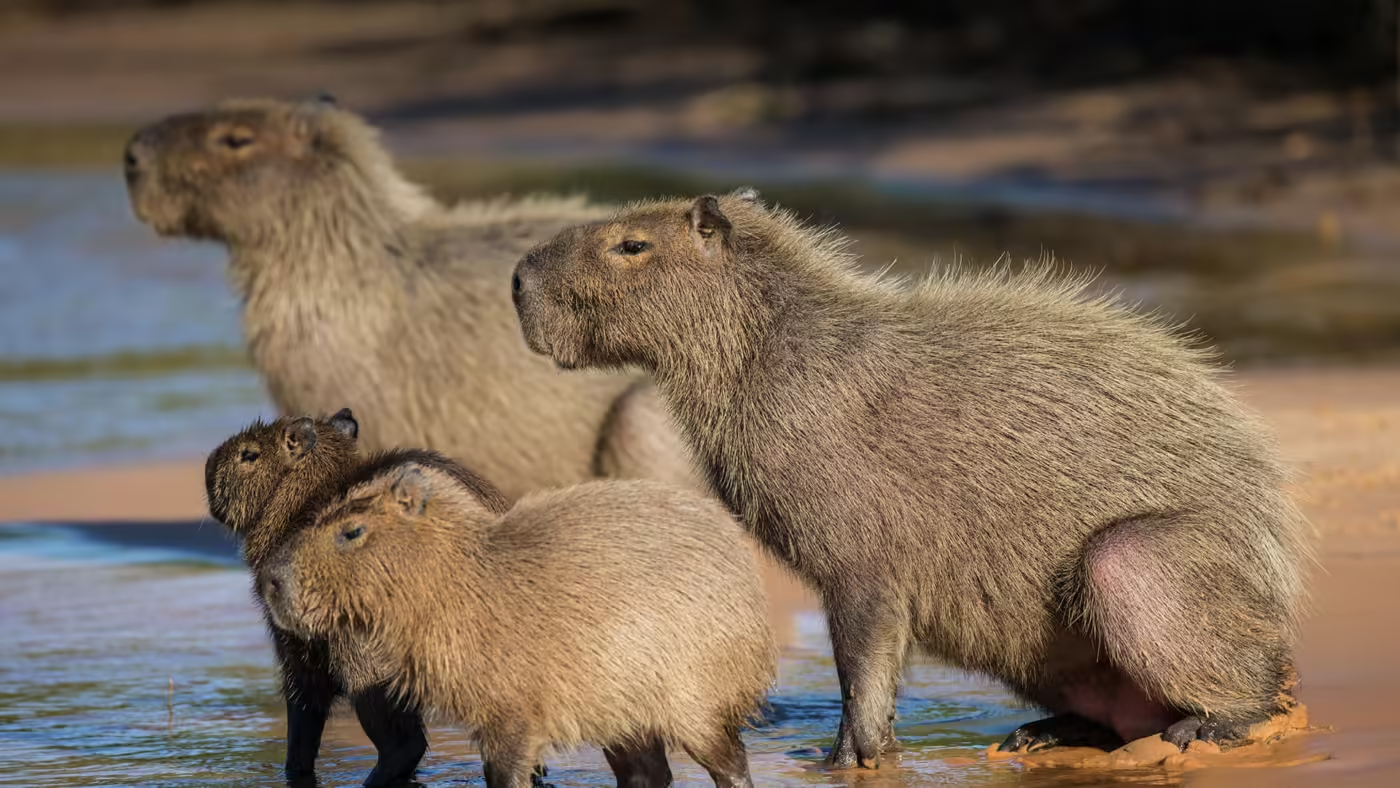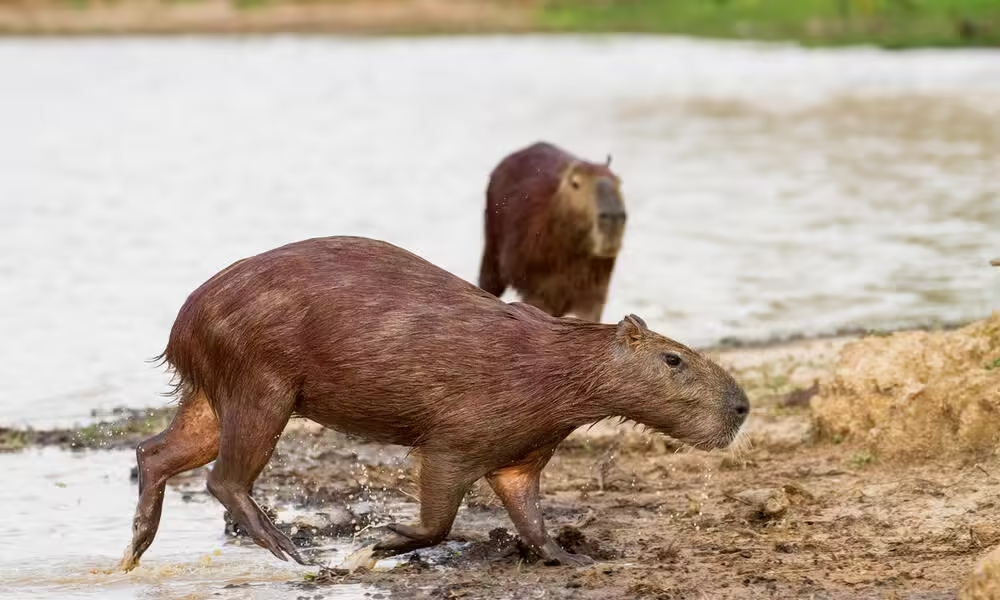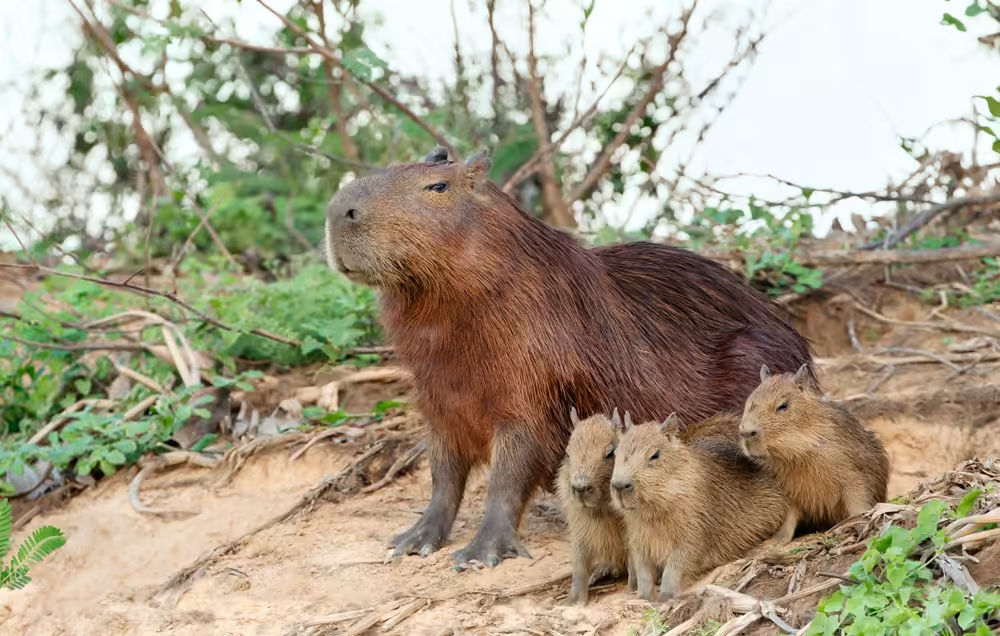Many people think the capybara is from Africa, but it’s not. These huge rodents call South America home, especially the Pantanal region of Brazil. They also live in parts of Colombia, Venezuela, Peru, Argentina, and Uruguay. Being the biggest rodents alive, they love the water and live near rivers, lakes, and swamps.
Key Takeaways
- Capybaras are the largest living rodents, native to South America, not Africa.
- They are found in the Pantanal region of Brazil and other parts of South America.
- Capybaras are semiaquatic, living near rivers, lakes, and wetlands.
- These giant rodents can weigh up to 150 pounds, much larger than North American beavers.
- Capybaras typically live in groups of 10-20 individuals, but their group size can increase to 50 or 100 during the dry season.
Introduction: Uncovering the Truth about Capybaras
Capybaras are intriguing rodents that grab people’s attention. They look like some African animals but are truly from South America. We’ll explore their true origins, habitat, and unique characteristics as the largest rodent in the world.
Capybaras are not from Africa, despite what many think. These giant rodents live in the tropical and subtropical regions of South America. They can be found from Brazil, Venezuela, Colombia, and Argentina to the Andes Mountains. Their impressive size, unique look, and love for water make them interesting to scientists and nature lovers.
The capybara stands out for its size and weight. These rodents can reach four feet long and weigh up to 64 kilograms. They are the largest rodents in the world. Their stout bodies, short legs, and rounded heads make them easily recognizable among other rodents.
Let’s dive deeper into the world of capybaras. We’ll learn about their habitat, what they eat, how they live together, and more. By understanding these amazing rodents, we can see their importance in ecosystems and support conservation efforts to protect them.
What Animal Looks Like a Capybara?
Capybaras are the biggest rodents alive, known for their unique look. They have a stocky body, short snout, and round ears. People often think they look like some African animals. But, they are really close to guinea pigs and other South American rodents.
Physical Characteristics and Similarities
Even though they look a bit like pigs, capybaras aren’t related to them or any African animals. They have special features like webbed toes and live partly in water. This is because they live in South America. Capybaras can be as long as 4 feet and weigh more than 145 pounds, making them the biggest rodents.
Capybaras also share traits with other animals from South America. For example, they live with jaguars, the biggest cats in the Americas, and Amazon river dolphins, the biggest river dolphins. These animals have learned to live together, forming special bonds.
Even though capybaras might look like some African animals, they are truly from South America. Knowing about their unique traits and how they interact with other animals helps us see how special capybaras are in the wild.
Is a capybara an African animal?
Capybaras are not from Africa. They live in the wetlands, grasslands, and forests of South America. Countries like Brazil, Colombia, and others are their home. They look a bit like some African animals but are truly from South America.
The capybara is the biggest rodent alive, weighing 35 to 65 kg (77 to 143 pounds). They eat plants and live near water, often underwater for up to five minutes. They live in groups of about 10-20.
People sometimes think capybaras are from Africa because they look a bit like some African animals. But they are really from South America. Knowing where they come from helps clear up any confusion.
“Capybaras are the largest rodents in the world, but they are not native to Africa – they are found only in South America. “
In conclusion, capybaras are not from Africa. They live in the wetlands and forests of South America. Knowing where they come from helps us appreciate their special place in nature.
The Capybara: World’s Largest Rodent
The capybara is a standout in the animal kingdom. It’s the biggest rodent in the world. These giant rodents can weigh between 77 and 143 pounds and reach up to 4.6 feet long. They are almost as big as the North American beaver, another large rodent.
Capybaras have a pig-like build, standing up to 2 feet tall at the shoulders. Their size and stature make them very noticeable and memorable. They are truly the “world’s largest rodent.”
“Capybaras are known to occupy various hollows filled with water, displaying a penchant for immersed water baths.”
Despite their size, capybaras are perfect for their life in and around water. They have special traits that help them live well in their wet home. This makes them very interesting to scientists and nature lovers.
Capybara’s Diet: A Surprising Twist
Capybaras, the biggest rodents, have a unique way of eating. They mostly eat aquatic plants, grasses, and tree bark. But, they also eat their own feces, which might surprise you.
This habit is because their waste is high in protein and microbes from the day before. By eating their feces, they get extra nutrients they couldn’t digest the first time.
Their digestive system is made to make the most of their tough plant diet. They have constantly growing incisors that help them chew through hard vegetation.
Their gut is full of microbes that help them digest their food. The main microbes are Firmicutes and Bacteroidetes, with Fusobacteria and Proteobacteria also playing big roles.
| Gut Microbiome Composition | Percentage |
|---|---|
| Firmicutes | 35.8% |
| Bacteroidetes | 31.5% |
| Fusobacteria | 15.3% |
| Proteobacteria | 8.4% |
This mix of microbes helps capybaras get the most nutrition from their plant-based diet. They are truly amazing creatures.
““Capybara Simulator” is a game where players help rescue capybaras. They must feed, water, bathe, and give love to the capybaras.
Semiaquatic Lifestyle of Capybaras
Capybaras are the biggest rodents alive, living in both water and on land. They live near rivers, lakes, swamps, and flooded grasslands. They are great at moving between water and land.
Adaptations for Water and Swimming Abilities
Capybaras have toes that are partly webbed, like paddles. This helps them swim easily. Their fur is long and dries fast, so they stay warm and can move well in and out of the water.
They can hold their breath underwater for up to 5 minutes. This is very useful for avoiding predators. By staying underwater, they can hide and stay safe, showing how well they are adapted for the water.
- Partially webbed toes for efficient swimming
- Quick-drying fur to maintain insulation on land
- Ability to hold their breath underwater for up to 5 minutes
Capybaras have special features that let them live in both water and on land. They move easily between the two, showing how well they have adapted. Their ability to live in both places is a sign of their success and the strength of these big rodents.
Social Behavior and Group Dynamics
Capybaras live in groups of 10 to 20, sometimes up to 50 or 100 in the dry season. They gather around water sources. Males fight for dominance, but females and young work together, caring for each other’s babies.
Hierarchies, Cooperation, and Interspecies Interactions
Capybaras get along with other animals, like birds, turtles, and monkeys. They even let these animals ride on their backs. This shows how adaptable and social they are.
| Behavior | Description |
|---|---|
| Herd Size | Capybara herds usually have 10 to 30 members, but can have up to 100 in the dry season. |
| Territoriality | These groups are territorial, with a range of 5 to 16 hectares. |
| Spatial Distribution | The way capybara herds spread out shows a complex pattern. They compete at small scales and group together due to their behavior and the environment. |
| Interspecies Interactions | Capybaras live peacefully with other animals, like birds, turtles, and monkeys, letting them ride on their backs. |
The way capybaras interact and live together is really interesting. They have a strict social order, work together, and even get along with other species. This shows how complex and adaptable they are.
Predators and Threats to Capybaras
Capybaras, the world’s largest rodents, face many threats from predators. On land, jaguars, with their strong jaws and ambush skills, prey on them. In the water, anacondas threaten them with their powerful coils.
The young capybaras are especially at risk. They face threats from pumas, ocelots, eagles, caracaras, caimans, and boa constrictors. These dangers come from the land, water, and sky, making the capybara community very cautious.
- Capybaras can hold their breath underwater for up to five minutes, a valuable adaptation to evade aquatic predators.
- Each capybara group typically consists of 10-20 individuals, providing a level of safety in numbers against potential attackers.
- Capybaras are highly social and communicate through a range of vocalizations, including purring, barking, and whistling, to warn the group of impending danger.
Despite their defenses, capybaras are threatened by habitat destruction, deforestation, and illegal poaching, especially in the Amazon. Conservation efforts are key to saving these remarkable rodents, the largest of their kind on Earth.
| Predator | Threat to Capybaras |
|---|---|
| Jaguars | Powerful ambush predators that target capybaras on land |
| Anacondas | Deadly constrictors that prey on capybaras in the water |
| Pumas, Ocelots, Eagles, Caracaras | Threats to capybara young from the land and sky |
| Caimans, Boa Constrictors | Aquatic and terrestrial predators that target capybara young |
“Capybaras are the largest rodents on Earth, almost twice the size of a beaver. Despite their impressive stature, they must remain vigilant against a variety of predators that threaten both the adults and their young.”
Lifespan: Wild vs. Captivity
Capybaras live longer in captivity than in the wild. In the wild, they usually live about 7 years, with some up to 10 years. But in zoos, they can live up to 12 years on average.
This big difference is because they don’t have natural predators in captivity. They also get a steady, nutritious diet. In the wild, capybaras face threats from jaguars, pumas, eagles, and caimans. These dangers cut their lives short. But in captivity, capybaras are safe and get special care, leading to longer lives.
| Lifespan | Wild Capybaras | Captive Capybaras |
|---|---|---|
| Average Lifespan | 7 years | 12 years |
| Maximum Lifespan | 10 years | Not Specified |
The lifespan of capybaras in captivity also depends on their care and environment. But the data is clear: they live longer when safe from wild dangers and well cared for.
“Capybaras are truly remarkable creatures, and their lifespan is just one of the many fascinating aspects of these giant rodents. By understanding the differences between their wild and captive lifespans, we can better appreciate the challenges they face in their natural habitat and the importance of conservation efforts.”
What animal is the cousin of the capybara?
The capybara is the biggest rodent in the world. It is closely related to guinea pigs and rock cavies. These animals all belong to the Caviidae family, which has been around for millions of years.
The capybara is much bigger than its cousins, reaching lengths of up to 134 cm and weighing up to 66 kg. Yet, it shares a deep history with the smaller guinea pig and rock cavy. They all belong to the Caviomorpha order, which started in South America.
The Caviidae family has 19 species across 6 genera and 3 subfamilies. The capybara, in the Hydrochoerinae subfamily, is the biggest of these rodents. On the other hand, guinea pigs, both domestic and wild, are much smaller, weighing between 0.7 to 3 kg.
Even though they differ in size, these rodents have many things in common. They all eat plants, have a special tooth arrangement, and have adapted to life in South America. The capybara’s big size and water-loving nature make it stand out. But, it still shares an evolutionary link with the guinea pig and rock cavy through the Caviidae family.
“The capybara, guinea pig, and rock cavy are all part of the Caviidae family, a diverse group of South American rodents that have evolved unique adaptations to thrive in their environments.”
Capybaras in Florida: An Invasive Species?
Capybaras, the biggest rodents, were first seen in Florida in the 1990s. They likely escaped from owners or small zoos. Now, there are concerns they might become invasive.
There’s no confirmed breeding yet, but signs show they’re starting to reproduce. Elizabeth Congdon from Bethune-Cookman University found capybara babies. This means their numbers are likely to grow.
About 100 capybaras live in Florida now, spread across several counties. Officials are watching them to see how they might affect the environment.
These rodents can get quite big, up to 140 pounds, and have a lot of babies. In South America, they’re seen as pests because they’re everywhere. Florida’s warm weather is perfect for them, which worries experts.
Florida already has many invasive species like the Giant African Land Snail and the venomous lionfish. Adding capybaras to the list worries environmental groups.
Even though capybaras aren’t officially invasive yet, Florida is watching them closely. If they keep growing, we might need new plans to protect our native animals and plants.
| Invasive Species in Florida | Year Arrived | Impact on Ecosystem |
|---|---|---|
| Giant African Land Snail | 1966 | Can carry parasitic worms |
| Cuban Tree Frog | 1940s | Migrated north via trucks |
| Spectacled Caiman | Unknown | Found in a few Southern Florida counties |
| Venomous Lionfish | Unknown | Swarms the Florida coast, causing problems |
The capybara’s effect on Florida’s nature is still unknown. But, Florida’s history with invasive species shows we must stay alert. As more capybaras appear, wildlife experts will keep an eye on them to protect our environment.
Capybaras are amazing creatures, the biggest rodent in the world. They live in the wetlands and grasslands of South America. They look a bit like pigs but are not from Africa. Instead, they call countries like Brazil, Colombia, Venezuela, Peru, Argentina, and Uruguay home.
These animals have interesting eating habits and can swim well. They also live in groups and have complex social lives. This makes them very interesting to people everywhere.
We’ve learned a lot about capybaras in this article. They can grow up to 50 cm tall and 130 cm long, and they weigh between 35-70 kg. This makes them the biggest rodent on Earth.
Their biggest groups live in places like the Taim lowlands in southern Brazil, the Pantanal in western Brazil, and the llanos of Venezuela. They like to live in groups of 6 to 10 animals.
In conclusion, capybaras are special animals. They are well-suited to their life in the water and are very social. People all over the world find them fascinating. Whether you just like to learn about animals or you’re a serious researcher, the capybara will always be an interesting topic.



